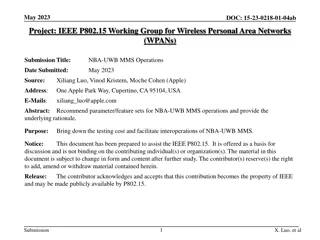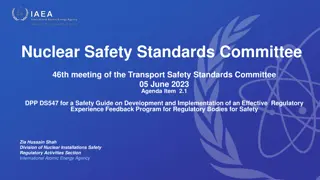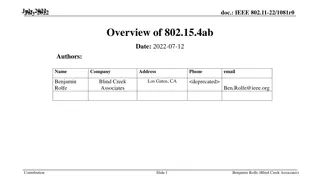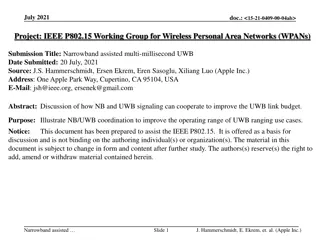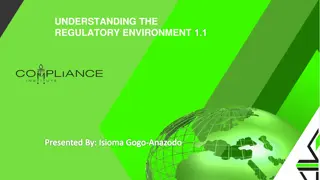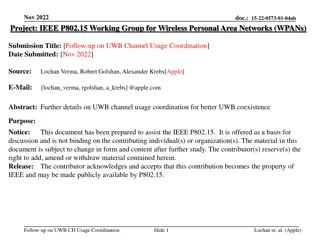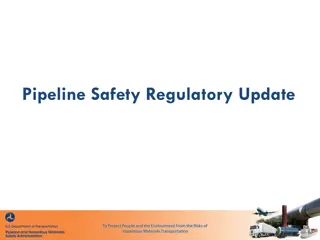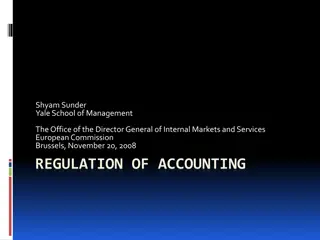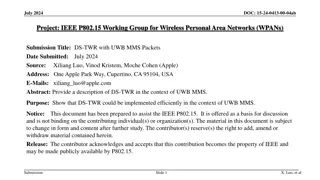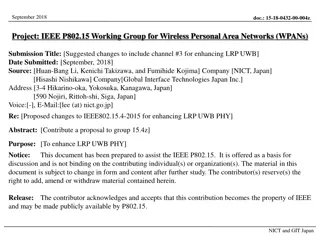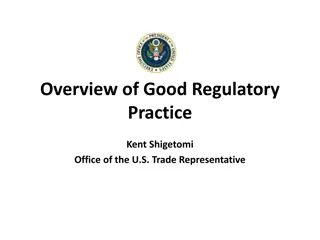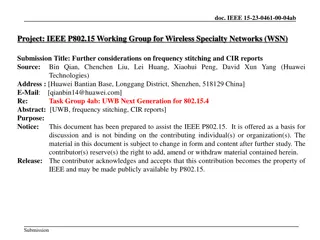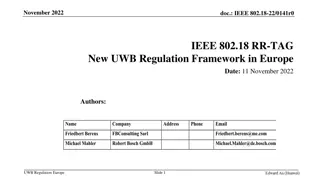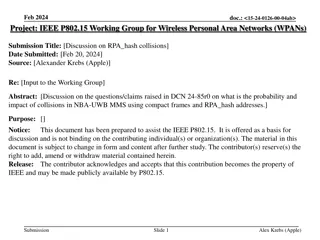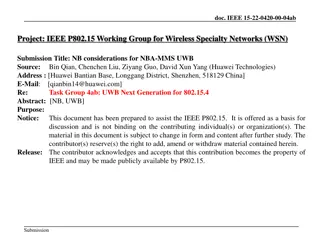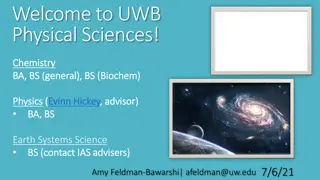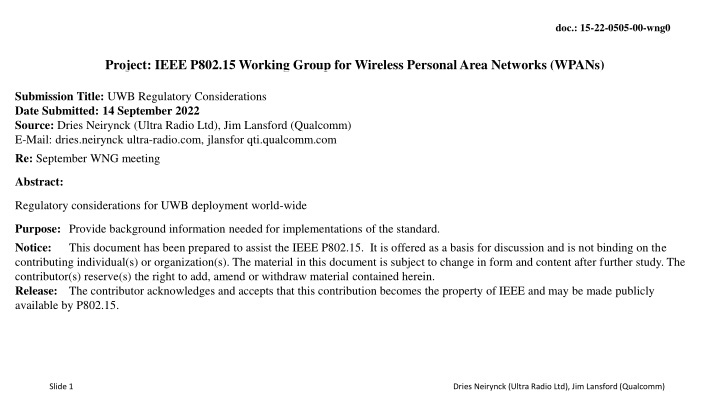
UWB Regulatory Considerations for Global Deployment
Explore the regulatory landscape surrounding Ultra-Wideband (UWB) technology for wireless personal area networks. Learn about varying regulations worldwide, considerations for deployment, and the evolving regulatory perspective on UWB technology. Stay informed on UWB operation fundamentals, including underlay technology, non-interfering principles, and regulatory frameworks like FCC regulations for UWB systems.
Download Presentation

Please find below an Image/Link to download the presentation.
The content on the website is provided AS IS for your information and personal use only. It may not be sold, licensed, or shared on other websites without obtaining consent from the author. If you encounter any issues during the download, it is possible that the publisher has removed the file from their server.
You are allowed to download the files provided on this website for personal or commercial use, subject to the condition that they are used lawfully. All files are the property of their respective owners.
The content on the website is provided AS IS for your information and personal use only. It may not be sold, licensed, or shared on other websites without obtaining consent from the author.
E N D
Presentation Transcript
doc.: 15-22-0505-00-wng0 Project: IEEE P802.15 Working Group for Wireless Personal Area Networks (WPANs) Submission Title: UWB Regulatory Considerations Date Submitted: 14 September 2022 Source: Dries Neirynck (Ultra Radio Ltd), Jim Lansford (Qualcomm) E-Mail: dries.neirynck ultra-radio.com, jlansfor qti.qualcomm.com Re: September WNG meeting Abstract: Regulatory considerations for UWB deployment world-wide Purpose: Provide background information needed for implementations of the standard. Notice: This document has been prepared to assist the IEEE P802.15. It is offered as a basis for discussion and is not binding on the contributing individual(s) or organization(s). The material in this document is subject to change in form and content after further study. The contributor(s) reserve(s) the right to add, amend or withdraw material contained herein. Release: The contributor acknowledges and accepts that this contribution becomes the property of IEEE and may be made publicly available by P802.15. Slide 1 Dries Neirynck (Ultra Radio Ltd), Jim Lansford (Qualcomm)
doc.: 15-22-0505-00-wng0 UWB Regulatory Considerations Dries Neirynck (Ultra Radio Ltd) Jim Lansford (Qualcomm) Slide 2 Dries Neirynck (Ultra Radio Ltd), Jim Lansford (Qualcomm)
doc.: 15-22-0505-00-wng0 -41.3 dBm/MHz mean, 0 dBm peak in 50 MHz? No so fast regulations vary: Per country Per application Per frequency range Slide 3 Dries Neirynck (Ultra Radio Ltd), Jim Lansford (Qualcomm)
doc.: 15-22-0505-00-wng0 -41.3 dBm/MHz mean, 0 dBm peak in 50 MHz? No so fast regulations vary: Per country Per application Per frequency range and over time: Success of secure ranging based on 802.15.4z is leading to many more countries allowing ultra-wideband worry that aggregation of UWB emissions will cause interference Slide 4 Dries Neirynck (Ultra Radio Ltd), Jim Lansford (Qualcomm)
doc.: 15-22-0505-00-wng0 In general, from a regulatory perspective UWB is an underlay technology operating on a non-protected, non-interfering basis Underlay technology: operates in spectrum licensed to other services Non-interfering: cannot cause harmful interference to those services Non-protected: must accept harmful interference from others 6 GHz UNII including from other non-protected, non-interfering applications Slide 5 Dries Neirynck (Ultra Radio Ltd), Jim Lansford (Qualcomm)
doc.: 15-22-0505-00-wng0 FCC 2002: First to introduce UWB CFR Title 47, Part 15: Operation without individual license 15.517 indoor UWB systems 15.519 handheld UWB systems -41.3 dBm/MHz mean, 0 dBm peak in 50 MHz in 3.1 10.6 GHz 10 dB bandwidth minimum 500 MHz Fixed outdoor emissions are prohibited 10 second rule for handheld devices Rules written under assumption that UWB would be used for communications Slide 6 Dries Neirynck (Ultra Radio Ltd), Jim Lansford (Qualcomm)
doc.: 15-22-0505-00-wng0 FCC 2006: First (and still last) update 47 CFR 15.250 - Wideband systems within the band 5925-7250 MHz Only update to UWB rules Minimum 10 dB bandwidth reduced to 50 MHz Fixed outdoor still prohibited But 10 second rule dropped Since 2006, only waivers Usually for specific devices from specific manufacturers Slide 7 Dries Neirynck (Ultra Radio Ltd), Jim Lansford (Qualcomm)
doc.: 15-22-0505-00-wng0 Meanwhile, in Europe First UWB rules in 2006 -41.3 dBm/MHz in 6.0 - 8.5 GHz Minimum 10 dB BW 50 MHz Same prohibition on fixed outdoor And lots of updates ever since Mitigation techniques (low duty cycle, detect and avoid) for 3.1 4.8 GHz and 8.5 9.0 GHz Specific applications (e.g. keyless entry for vehicles) Slide 8 Dries Neirynck (Ultra Radio Ltd), Jim Lansford (Qualcomm)
doc.: 15-22-0505-00-wng0 European highlights ECC Decision (06)04 First approved March 2006, last updated 2019 Voluntary coordination between CEPT member states Currently being revised To allow fixed outdoor transmissions To allow 10 dB extra power indoors To simplify vehicular use All between 6.0 8.5 GHz European Commission Decisions Largely copies of ECC Decisions but mandatory for single market members Currently Decision (EU) 2019/785 ETSI Harmonised Standards EN 302 065 series Slide 9 Dries Neirynck (Ultra Radio Ltd), Jim Lansford (Qualcomm)
doc.: 15-22-0505-00-wng0 The rest of the world Most countries implement either CEPT or FCC framework CEPT framework mainly in Europe, Africa and Asia Particularly China, Japan and Korea have own rule sets FCC framework mainly in North and South America Slide 10 Dries Neirynck (Ultra Radio Ltd), Jim Lansford (Qualcomm)
doc.: 15-22-0505-00-wng0 Slide 11 Dries Neirynck (Ultra Radio Ltd), Jim Lansford (Qualcomm)
doc.: 15-22-0505-00-wng0 Liaison Statement Extract ETSI TC ERM TGUWB has previously published ETSI TR 103 181-3 (V2.1.1, 2019-01), an overview of UWB regulations between 3.1 10.6 GHz worldwide. Since then, many states have introduced UWB regulations. In this context, ETSI TC ERM TGUWB is now working on a revision of TR 103 181-3 and we would appreciate if any IEEE member could contribute to this revision. From our side, ETSI TC ERM TGUWB would be happy to provide any information you may require on the applicable CEPT/EC spectrum regulations and the corresponding ETSI standards. We will also inform you once the revision of TR 103 181-3 has been published. (see 802.18-22/0060r0) Slide 12 Dries Neirynck (Ultra Radio Ltd), Jim Lansford (Qualcomm)

